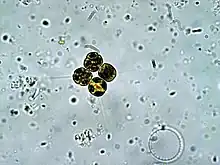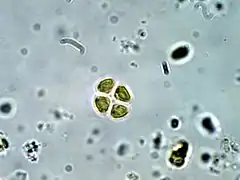| Tetrastrum | |
|---|---|
 | |
| Tetrastrum heteracarthum | |
| Scientific classification | |
| (unranked): | Viridiplantae |
| Division: | Chlorophyta |
| Class: | Chlorophyceae |
| Order: | Sphaeropleales |
| Family: | Scenedesmaceae |
| Genus: | Tetrastrum R. Chodat, 1895 |
| Type species | |
| Tetrastrum heteracanthum (Nordstedt) Chodat, 1895 | |
| Species | |
| |

Tetrastrum is a genus of green algae (Chlorophyta). It is a common component of the phytoplankton of freshwater habitats, particularly eutrophic and alkaline waters.[1][2]
Although traditionally classified in the family Scenedesmaceae in the class Chlorophyceae, it is phylogenetically more closely related to the genus Oocystis of the family Oocystaceae (Trebouxiophyceae).[3]
History
The genus Tetrastrum has a tangled taxonomic history. The name was first coined in 1895 by Robert Chodat for the species Tetrastrum heteracanthum, which was previously placed in the now-obsolete genus Staurogenia. Later, the genus Cohniella was created by Ludwig Julius Bruno Schröder, containing the species Cohniella staurogeniiforme. Later, Ernst Lemmermann merged the genus Cohniella into Tetrastrum.[3]
Description
Tetrastrum consists of four-celled colonies, which are sometimes aggregated together to form compound colonies. A layer of mucilage surrounding the colony is sometimes present. Cells are tightly joined in a flat plane, with or without a small space in the middle. Cells are ovoid, triangular, or trapezoidal, 2–11.5 μm long. Some species may have spines on the cells; these spines are up to 46 μm and show various morphologies, such as one long spine and one short, or multiple short spines. Cells contain one nucleus and one to four chloroplasts, with or without pyrenoids. The cell wall appears smooth in light microscopy, but is covered with small granules which are visible in scanning electron microscopy.[1]
Tetrastrum reproduces asexually through the formation of autospores. Four autospores are formed, organized into the shape of the colony; these are released through a tear in the mother cell wall.[1]
Identification
Tetrastrum is similar to, and has been taxonomically confused with, other genera such as Crucigenia. The main morphological difference between the two is the mode of reproduction. In Tetrastrum, the daughter colonies are produced with the cells in the same orientation as the mother cells. In Crucigenia, the daughter colonies are produced with cells rotated 45° relative to the mother cells' orientation. Additionally, Tetrastrum may produce spines on its cells, while Crucigenia never does.[3] Some species once classified in the genus Tetrastrum have been reclassified into the genus Lemmermannia. Lemmermannia has square colonies that lack spines, and can sometimes form compound colonies; in contrast, Tetrastrum has colonies with spines, or in the case of the spineless Tetrastrum glabrum, has oval and not square colonies).[3][4]
Species of Tetrastrum are identified based on the size and shape of the cells, placement and length of the spines, and presence or absence of pyrenoids.[1] Considerable variation exists within species, blurring species boundaries.[5]
References
- 1 2 3 4 Guiry, M.D.; Guiry, G.M. "Tetrastrum". AlgaeBase. World-wide electronic publication, National University of Ireland, Galway. Retrieved 2023-12-06.
- ↑ Bicudo, Carlos E. M.; Menezes, Mariângela (2006). Gêneros de Algas de Águas Continentais do Brasil: chave para identificação e descrições (2 ed.). RiMa Editora. p. 508. ISBN 857656064X.
- 1 2 3 4 Bock, Christina; Luo, Wei; Kusber, Wolf-Henning; Hegewald, Eberhard; Pažoutová, Marie; Krienitz, Lothar (2013). "Classification of crucigenoid algae: Phylogenetic position of the reinstated genus Lemmermannia, Tetrastrum spp. Crucigenia tetrapedia, and C. lauterbornii (Trebouxiophyceae, Chlorophyta)". Journal of Phycology. 49 (2): 329–339. Bibcode:2013JPcgy..49..329B. doi:10.1111/jpy.12039. PMID 27008519. S2CID 46206435.
- ↑ Komárek, J.; Fott, B. (1983). Chlorophyceae (Grünalgen), Ordnung Chlorococcales. Das Phytoplankton des Süßwassers (in German). E. Schweizerbart'sche Verlagsbuchhandlung. p. 1044.
- ↑ Ahlstrom, Elbert H.; Tiffany, Lewis H. (1934). "The Algal Genus Tetrastrum". American Journal of Botany. 21 (8): 499–507. doi:10.2307/2436189. JSTOR 2436189.
- "Tetrastrum". Integrated Taxonomic Information System. Retrieved 19 September 2007.
- D. Garbary and E. Hegewald (17 Aug 2004). "Tetrastrum Genus detail". AlgaeBase. Retrieved 2007-09-19.